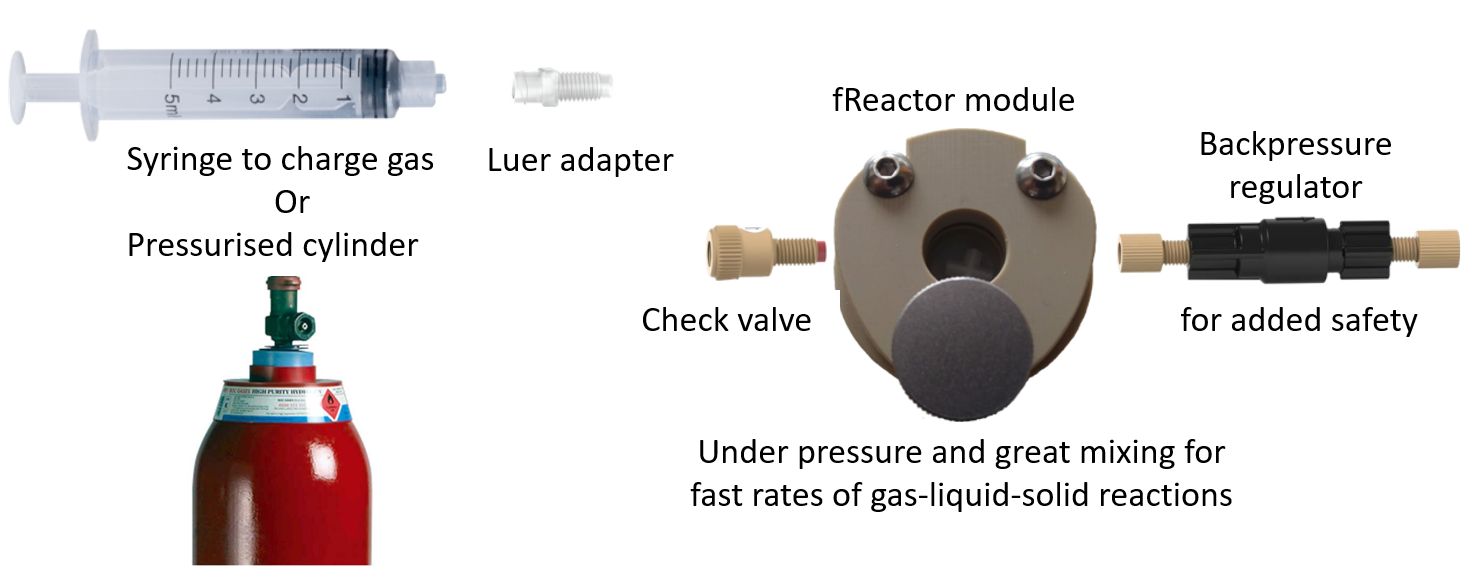The fReactor as a batch hydrogenator
The fReactor turns out to be a very capable miniature batch hydrogenator - allowing pressure to be easily charged using a syringe, having excellent mixing (giving good gas-to-liquid transfer) - all working together to allow rapid and efficient reactions. By operating at 7 bar immediately gives you 7 times the rate that you would see with a balloon-on-a-bottle setup, and the combination of heating and enhanced mixing further increases the rate - allowing your hydrogenations to take place in a fraction of the time you might otherwise be waiting.
A recent study on the use of the fReactor-Classic as a batch and flow hydrogenator , showed that when using 0.5ml of fluid in the fReactor classic, with the remaining headspace as a gas, gave a mass transfer rate of ~3 times that of the more traditional larger Parr reactors operating under pressure.
Having 5 fReactors set up in batch mode together allows you to screen for conditions, or by starting off with the same reactants, following the kinetics by periodically stopping one reactor after another (e.g. removing it from the hotplate and quenching the reaction). You can even screen under batch conditions and then move to flow!
In addition to using a cylinder of gas and regulator as a way of pressurising the reactor, we also developed a quick method with just a syringe to pump up the reactor to elevated pressure.

With the syringe setup shown above, the fReactor can be pressurised using a syringeful of gas. An example of operation would be:
- Initially the pressure within the reactor is 1 bar (ie atmospheric pressure). You might have purged the reactor if air sensitive. The syringe is filled with gas (also at 1 bar).
- You attach the reactor with the luer connector.
- Depressing the plunger fully (ie to the very bottom of the syringe), the pressure rises until the check-valve opens and the pressure rises within the reactor.
- The small deadspace in the base of the syringe means when the plunger is released, there is a residual volume of gas in the syringe, that springs the plunger back.
- Refilling the syringe and repeating charging the reactor increases the pressure further (the 'Simulate next fill ...' button allows you to conveniently simulate this).
- Finally you detach the syringe, leaving your reactor ready for heating and stirring.
The modeller below allows you to simulate this process. Once you have the final pressure (and knowing the volume of gas in the reactor), you can then go on and calculate the moles of gas you have. Generally you would run with an excess of hydrogen in your reaction, recognising that as the hydrogen is consumed, the pressure will fall.
Typical deadspace in plastic syringe 0.23ml; Empty fReactor-classic with stirrer bar 1.6ml; small diameter syringes (5ml,10ml) are easier to push than large syringes!; The cracking pressure will be given on your check valve (e.g. this one is 1 bar (15psi).
Heating the reactor after charging will see a further rise in pressure. Keeping the maximum pressure (after heating) below that of the BPR is important; due to the hysteresis of the valve, once it opens the pressure falls below the rating of the BPR, giving you an uncertainty in operating point.
How good is the model ? Well we ran tests with a pressure probe connected to the reactor and estimate within 10%.
